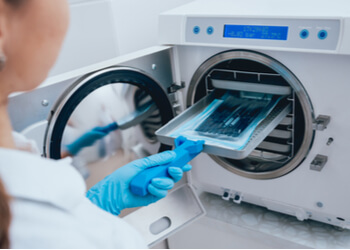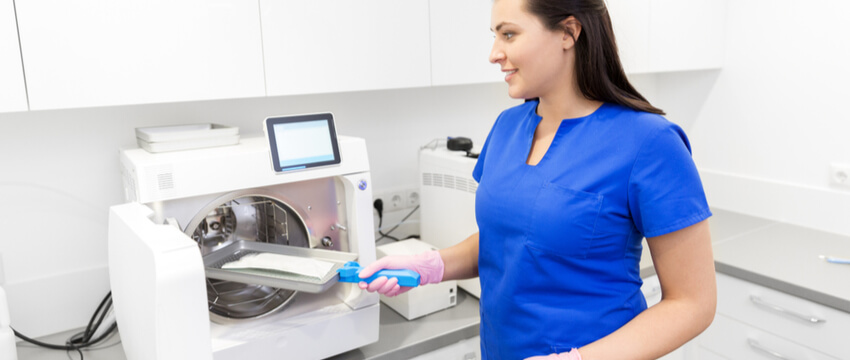In today’s market, Melag autoclaves, staples of the Melag Hygiene World, are considered the leaders in sterilising machines created for medical environments.
What types of autoclaves are available?
Autoclaves are available in bench top or floor models. Bench top models are ideal for practices or clinics that are short on space. Floor models are free standing and typically have a larger capacity and are a good sterilising solution for practices with a larger client base.
Melag autoclaves vary in size and shape. So, it is possible to sterilise objects that come in different forms and sizes, provided that you have an appropriately sized chamber. Basic autoclaves come in a smaller size and shape similar to that of a pressure cooker. Tabletop autoclaves, which resemble the size and shape of a microwave oven, are some of the most popular autoclaves found in dental and medical clinics. Horizontal autoclaves are generally found in hospitals and are the largest.

What are the components of an autoclave?
What is an autoclave and how many parts does it come with? Autoclaves consist of several parts, and the exact materials or appearance can vary between brands. Inside an autoclave, there is a chamber where the tools are placed ahead of their sterilisation, trays which hold the objects, water/steam monitoring systems, and a built-in drying structure.
Depending on the size and functionality of your autoclave, more add-ons may be available, but most autoclaves have the following components:
- Chamber: the chamber consists of an inner chamber and an outer jacket.
- Control system: all autoclaves are equipped with a controller interface.
- Thermostatic trap: this critical device allows air and water to escape from the chamber, enabling the passage of dry steam.
- Safety valve: this fail-safe device is in place in case the electronic controls fail.
- Waste-water cooling mechanism: the steam must be cooled before it can go down the drain, so most autoclaves are equipped with a system to cool the effluent. Because the steam is mixed with cold tap water, some autoclaves are equipped with a mechanism to reduce or eliminate water consumption.
- Vacuum system: some autoclaves include a vacuum system to prevent microorganisms from surviving in air pockets of porous materials like cloth.
How do autoclaves work?
Regardless of size, whether it is a bench top or floor model or top-loading or front-loading, autoclaves use the same process to sterilise an object. The most basic autoclaves harness the power of steam to kill bacteria, even those spores and germs which may have become resistant to boiling water or professional-grade detergents.
There are essentially three phases in the sterilisation cycle:
- Purge phase: steam flows through the steriliser, increasing the temperature and pressure.
- Sterilisation phase: the exhaust valve is closed, causing the temperature and pressure to reach the desired sterilisation point. This cycle is maintained until the desired sterilisation period is obtained.
- Exhaust phase: the pressure is released through an exhaust valve until ambient pressure is restored, although the contents are still hot.
Autoclaves heat materials, objects, and tools inside them to a temperature above the boiling point (100 degrees Celsius). The standard temperature is 121 degrees Celsius. Bacteria, viruses, fungi, parasites and other microorganisms are unable to survive at this temperature, so your dental instruments are medically disinfected.
While objects are being sterilised, the autoclave locks automatically as a safety mechanism and unlocks immediately after the cleaning has finished and when the tools are dry.
Depending on the model and size of the autoclave, as well as which items are placed inside of it, the average autoclave sterilisation sessions can last between 6 and 30 minutes.
Why is steam so effective in killing bacteria and other harmful spores?
Steam is an effective sterilising method because it is so hot that when it comes into contact with another (colder) surface, it transfers enough heat energy to kill any bacteria residing on the foreign surface immediately.

What should I look for in an autoclave?
- Loading capacity: consider the length of your longest instrument or the size of your surgical pack to determine the depth or the volume of the chamber. The size of your patient base is another crucial component that must be reflected in your autoclave purchase. If your practice is busy with patients and you have very little time between appointments, fast and effective autoclaves like the MELAG MELAquick 12+ p can sterilise your hand instruments in as little as 7 minutes.
- Use of space: size constraints are another significant factor. If your clinic is tight on space, basic autoclaves like the MELAG MELAquick 12+ which is only 20.5 x 45 cm in size is an excellent solution. This autoclave is extremely compact but is just as effective in sterilising up to 12 handpieces. If space is not an issue for your practice or clinic, consider the MELAG 31B AUTOCLAVE PROCLASS and MELAG 41B AUTOCLAVE.
- Easy installation: modern autoclaves require water, electricity and possibly ready-to-use steam in order to operate. Consider all your options when choosing the best autoclave for your practice, including those that require only a power socket and have an internal water connection for easy installation and placement.
- Easy to use and clean: choose a model that is easy to load and unload as well as clean. Front-loading models have to be positioned higher up for easy loading and unloading.
- Warranty: ensure the warranty covers parts and labour and that replacement parts are easy to find in case your model is discontinued.
- Sterilisation requirements: different instruments require different cycles of sterilisation. Consider what will work best for your specific needs – a pre-vacuum or gravity autoclave. Steam quality is also important because it ensures the quality of sterilisation and how safe your tools are to use. Steam quality is determined based off two major parameters: moisture levels and the levels of non-condensable gases. The optimum, bacteria-killing steam is 3% liquid and 97% gas. If this balance is changed, this can adversely affect your quotas and time management capabilities.
Which Melag autoclaves are on the market today?
At Melag Autoclave, we have over 15 different autoclave models ranging in size and capacity. No matter how demanding your practice or clinic may be, you can find the perfect model to satisfy all your needs.
Some of our most popular Melag autoclaves include:
Generally known as the all-around autoclave, the MELAG Vacuklav 23 B+ has all the sterilisation space you could ever need from a dental autoclave. It is also a complete stand-alone model; all it requires to function is a power socket.
Made for both large scale clinics and medical departments, this extra-large autoclave is also extra-economical as it uses less electricity and consumes less water to get the same, excellent job done.
Where to buy a Melag autoclave?
From basic dental products to surgical equipment, family owned business, Melag Autoclave has an extensive range of products at affordable prices.
The Melag Autoclave team has more than 19 years of experience in the steam sterilisation industry and provides support to the dental and medical field. We can answer all your questions from “What is an autoclave” to more nuanced requests regarding autoclave upkeep and maintenance of specific models.
Melag Autoclave has a steadfast commitment to deliver high-quality and high performance Melag autoclaves and other dental and medical supplies. For more information about any of our products, please call us on (02) 8880 7813 or email us at info@criticaldental.com.au.


